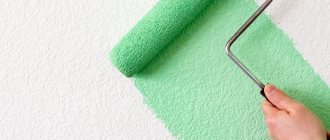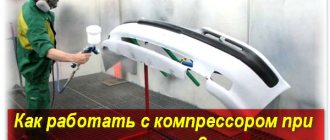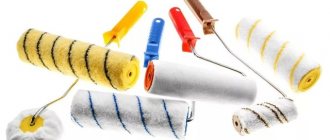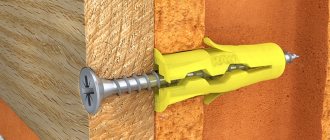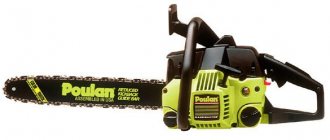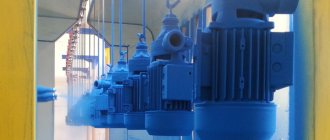One of the most common tools for applying paint is a paint roller.
However, coloring is far from the only area of its application, and to solve each problem, its corresponding type is selected, of which there are more than a dozen.
The tools have different coatings on the working part, sizes and shapes, and include special types.
At the same time, the characteristics of the surface being processed, the material being applied and the conditions of use completely determine which roller to choose for specific tasks.
Further on, what is this tool for, what are its advantages, features, main types and their estimated cost.
Purpose and operating principle of rollers
The purpose of the roller depends on its coat, which is discussed in more detail below.
This is how, in fact, the main division into types is carried out, for example:
- Paint rollers - used for applying various paint coatings.
The roller coat absorbs the paint, after which painting is performed by rolling the rotating part (roller) over the surface to be treated. - Models for plastering - to create texture on a freshly plastered surface.
In other words, on the working part of the roller there is a three-dimensional pattern that pushes through the top layer of plaster or any other material with similar parameters, leaving an imprint. - Options for self-leveling floors - used to remove air from a newly poured solution.
Design
The tool consists of a metal locking handle, a working surface (roller) and a fur coat. Sometimes rollers with protection are also used. Depending on the size, purpose, and design features of the clasp, various types of tools are produced.
The roller consists of a metal handle-lock, a working surface and a fur coat
If you don’t know how to choose a paint roller, you should first consider the amount of work to be done. A tool with a large fur coat and a long handle is ideal for working on the surface of walls, for working on the floor or ceiling. It is better to choose a mini for creating rolls, engravings, stencils, for working with corners, and applying liquid paints.
The handle of the tool is very important for comfortable and efficient work. It should not interfere with the use of the roller tray, should not slide, dangle, or interfere with the application of liquid compositions.
Most handles are designed to allow the use of a stationary extension of the structure. Before choosing a roller for painting, carefully inspect the plastic of the handle and the connector for the extension cord. It may have different types of latches, which may be intended, among other things, for factory extension cords, which will entail additional costs. The handle makes it easy to handle:
- vinyl wallpapers;
- doors;
- liquid wallpaper on walls and ceilings;
- carry out work on applying bitumen on the roof;
- paint wooden floors with oil paint.
In this case, the plasterer performs all the work from one place, covering a large area around him. With the attachment you can quickly paint technical rooms, roofs, high walls, and treat ceilings.
Using a roller with an attachment, the painter paints technical rooms, roofs, high walls, and ceilings much faster
Device and characteristics
The design of the roller, regardless of its purpose, includes two main elements:
- The machine consists of a clasp and a handle. The first is a metal base on which the working part is attached. The entire structure is made in the form of a curved rod with a handle for holding.
- Working part. In most cases, this is a roller (reel) in the form of a tube made of plastic, on top of which a coating of various materials is applied, depending on the purpose. The working surface is called a fur coat.
Construction stores sell both assembled rollers and in the form of component parts: a roller with a fur coat and a clasp.
The latter option is preferable for large-scale work, since when the coat wears out, you can save money by purchasing only a replacement element and installing it on the clasp.
Dimensions and weight
Rollers are divided into the following types according to the width and diameter of the working cylinder:
- Mini roller – up to 150 mm and about 15 mm, respectively. Suitable for processing small areas, surfaces with complex terrain or places that are difficult to reach.
- Midi roller – 150 – 250 mm and 50 – 90 mm, respectively. A universal size, which is suitable for most jobs, including painting smooth or slightly embossed surfaces, leveling wallpaper when pasting.
- Maxi-roller – more than 250 mm and more than 80 mm, respectively. The work requires certain skills, since the tool belongs to the professional class. It is used when carrying out facade work, especially if the texture of the surface being treated has many irregularities.
Additional roller sizes include:
- Rod diameter (inner diameter of the cylinder). For most models it is 6 or 8 mm.
- The length of the handle also varies, and in accordance with this parameter, the rollers can be divided into: short - up to 350 mm, medium - from 350 to 450 mm, long - more than 500 mm. If necessary, you can purchase a special extension cord, which, in turn, can be telescopic.
In this case, the increase in the length of the roller can be 70–400 cm. - Weight – 100 – 300 g depending on the material and length of the handle. For rolling models, handle extensions are used, the weight of which can exceed 1 kg.
NOTE:
The given divisions of rollers into subtypes by size are purely arbitrary, and each manufacturer is independently able to classify their products based on personal preferences.
Another characteristic is the length of the pile.
For each fur coat material it is individual.
In addition, a fleecy coating is usually called a fur coat, and a bobbin with a lint-free coating is simply called a roller.
How to understand tool sizes
Rollers have their own division by size. To have a visual representation of this topic, you can view photos of paint rollers. You will find that having different parameters makes the workflow much easier. Comfortable conditions for working with the tool are created.
First of all, the dimensions of the main part – the cylinder – are taken into account. The handle parameters are of lesser importance. This characteristic breaks down instruments into the following types:
- Type – mini. The cylinder has a diameter of no more than 9 cm and a height of about 15 cm. The product is suitable for painting surfaces in hard-to-reach places.
- Type - midi. The diameter is the same, but the height is increased to 20 cm. The tool is universal and is recommended for finishing walls, ceilings and other wide surfaces. An additional advantage is the low weight of the roller.
- Maxi type The length of the roller reaches 30 cm, and the diameter is 8 cm. This roller is a professional tool. Accordingly, its price will be significantly higher than previous types.
This tool can be used both on interior and exterior façade work.
Types of rollers and fur coats
According to the domestic classification, paint rollers are divided into:
- VMP – fur nozzle for painting floors.
- VP is a foam nozzle designed for water-based adhesive compositions.
- VMU – natural fur. The product is intended for painting corners.
- VM – fur covering.
According to the classification of foreign manufacturers, rollers are:
- PE – polyester based
- N – based on natural material
- PC – from polyacrylic modifications
- PA – from varieties of polyamides
So, depending on the material of the working surface, the roller coat is:
- Polyamide - made of artificial fiber with increased wear resistance to abrasion and chemical attack.
The main purpose is the application of water-dispersion paints. The length of the pile is 8 - 20 mm, and the longer it is, the easier it is to apply the coating to a rough surface. - Polyacrylic (acrylic) – has a dense pile, which reduces paint splashing during operation. Made from polyacrylonitrile, which is a synthetic fiber reminiscent of wool, and in most respects it is the same as the previous version.
Attention!
It is not intended for working with materials with aggressive components, which means it is suitable for applying water-based paints.
- Polyester - polyester, reminiscent of padding polyester. Extremely cheap to produce, has excellent absorption and retention properties.
When working on the surface being treated, it does not leave lint. The advantages are compensated by low mechanical resistance and the same durability. - Fur is a generalized name for two types of fur coats. Thus, the option made from natural fur is made from sheep wool and is suitable for treating any surface with varnishes, enamels, water-dispersion, and oil paints.
NOTE:
Not recommended for use with lime-based compounds.
Options made of faux fur - vestan, are used for applying any type of paint, and therefore are universal.
- Velor - plush pile is supported by a fabric base.
Suitable for finishing work on smooth surfaces. Tolerates solvents well. - Foam rubber. It is used for applying water-based varnishes, as well as water-dispersion paints. Essentially, this is polyurethane, which, among its other technical characteristics, has a density, the indicator of which is directly dependent on its service life.
The fur coat does not cake and quickly restores its original shape. The fibers are arranged in such a way that during operation they leave small air bubbles, which means an uneven final surface. - Flock is a textile base with glued polyurethane fiber. Features include strength, environmental friendliness of the material, and water resistance.
- Nylon is a representative of polyamide, which means it has the same properties.
- Felt is an environmentally friendly soft fur coat, suitable for various types of surfaces.
Felt copes well with paints based on aggressive solvents. - Thread - a roller made of fluffed nylon or polyacrylic thread, another name for a thread coat. Designed to work with water-based and oil-based paints.
- Rubber - most often the pressure roller is designed to expel air and increase adhesion when gluing wallpaper.
- Made of microfiber - suitable for working with antiseptics, impregnations, primers, glazes, as well as water-based paints. Microfiber has good absorbency and impact; it is used when processing both completely smooth surfaces and those with slight roughness.
They also use silicone coats for applying decorative patterns and leather coats for working with Venetian plaster.
Latex paints require a synthetic coat.
As for the rollers, the most common materials used are plastic and aluminum, and less commonly, wooden ones.
Rollers with plastic rollers are generally the cheapest due to their ease of manufacture.
It should be noted that the roller may have a connecting seam or be seamless.
The latter option is preferable, since otherwise the movement of the roller along the surface to be treated is hampered at the seam site, which leads to disruption of the uniformity of the applied paint layer.
The presence of a seam is also eliminated by the so-called circular knitted base of the fur coat with a uniform layer of roller coating.
Fastening fur coats
Depending on the type of attachment of the fur coat to the roller, the tool can be:
- Glued – with a non-removable working surface. A narrow strip of fur coat is wrapped around the base with glue applied, forming a joint joint to joint. This type of fur coat fastening system is seamless, since the seam runs in a spiral, which means that the paint is applied evenly during operation.
- Thermo-glued - the fur coat is soldered into a cylindrical base. The design is more durable and reliable due to the absence of glue.
- Sewn - rectangular fabric sewn to fit the shape of a sleeve.
- With a replaceable coat.
In the latter case, a quick-release system of one of the options is used to attach the fur coat:
– Rod (clasp) – a monolithic handle with a rod onto which a roller with a rotation and fixation device mounted inside is placed. The simplest option.
– Frame – the fur coat is fixed on a roller made in the form of a hollow cylinder-frame. The clasp contains bearings on which the equipment is installed. That's why this tool is called a frame roller.
There is also a so-called special fastening system, implemented on long rollers.
The rectangular frame has an axis secured by means of a thread, onto which a roller with end bushings is mounted.
Painting walls with a roller
Painting walls with a paint roller, a process that will include several stages:
- Preparatory. It is necessary to prepare the surface for work by filling up uneven areas with putty or plaster, and covering the base with soil. Once the primer has dried, you can begin painting.
The roller itself must be prepared for work: the tool is soaked for 2-3 hours in a soap solution, washed and dried. The stage of preparing the roller for use cannot be ignored, as otherwise the product may leave fluff and threads on the painted surface.
- Having prepared the surfaces and tools, you can proceed to painting. To do this, the paintwork material is poured into a special deep container and the roller is dipped into it. Important! The roller should not just be dipped, but rolled out over the container, so the paint will lie more evenly on the coating of the cylinder. You need to roll the roller over the bath several times.
- Next, you should decide on the place to start work; it is preferable to start painting from the corner area of the room and then move in any convenient direction.
- Using a roller, you need to evenly paint the surface and make sure that there are no gaps or drips. To do this, you should not put too much pressure on the tool and all movements should be made as smoothly as possible, in the direction from top to bottom.
In order for the surface to acquire an intense color, the paint is applied in several layers. It will not be possible to paint the corners completely with a roller: special brushes are used for this work.
Types of rollers and their prices
Each construction roller can be classified into one of the following types:
- Painting – used for applying paint and varnish coating. The price depends on the material of the fur coat, ranging from 100 to 1200 rubles and above.
- Special – for performing other tasks.
The first option, depending on the fur coat or the design of the clasp, can be:
Universal
Suitable for working with any flat surfaces, including ceilings and walls, capable of applying enamels, varnishes and paints.
For working with specific compositions, for example, exclusively for applying water-based paints.
Radiator
Roller on a wire extended handle with a thin roller.
Purpose – painting the back surfaces of pipes and radiators, where it is impossible to reach with a regular clasp roller.
The cheapest one will cost 50 rubles.
Facade
Its characteristic feature is the large diameter of the roller, which increases the working surface area, a long handle, and most importantly, the presence in the design of a bearing that slows down rotation at high speeds.
As a rule, such a roller has a longer pile, and in combination with other characteristics, it increases the convenience and speed of processing surfaces with a large area.
Facade tools are often produced with a telescopic handle, which largely distinguishes them from models for interior work.
Price – from 200 rubles.
Angular
It has a small width roller that resembles a wheel, which allows you to easily paint corners and similar hard-to-reach places.
Price – from 130 rubles.
Special rollers include the following options:
Pressing (smooth)
They are used for applying adhesives, but mostly to remove air bubbles from under the material, mainly wallpaper.
This type of wallpaper roller has a rubber or polyurethane roller coating, also called a rolling roller.
The tool comes with a conical roller or a “barrel” shape.
At the same time, the rollers for wallpaper and for wallpaper seams are different.
Price – from 70 rubles.
Needle
There are several types of tools depending on their purpose.
For example, a drywall roller has sharp spikes on the working surface, which pierce the surface when rolled.
This is done so that the inner layer is better saturated with moisture for the subsequent giving of a certain shape to the sheet, say, under an arch.
Options for self-leveling floors can be studded with soft needles designed to remove air bubbles from the thickness of the poured material.
Price – from 200 rubles.
Textured
The general name for rollers for forming textured surfaces.
Thus, a structural tool has a coat that gives plastered and putty surfaces (in principle, from any structural composition) a decorative texture.
Another name is decorative roller.
Paneled (patterned)
It is quite rare on sale, and its purpose is decorative painting, excluding the use of a stencil.
This painting tool is designed for applying paneling.
The frame type of construction allows you to install a roller with any pattern of interest.
In addition to the classic mechanical rollers, which periodically have to be dipped into a tray of paint, there are options with a refill function.
They are designed to work with liquid water-based compositions, and the roller design has a side cover that locks the internal cavity into which paint is poured.
On the one hand, such a roller is convenient to use, on the other hand, it is disposable, since even if you rinse it well after use, the next time you use it, the paint will no longer appear on the fur coat with its original effectiveness.
What to consider when choosing and using?
Each type of paint has its own material
So, for primer and antiseptic, you can safely buy an inexpensive roller with any working surface material. Whether it is foam rubber, polyacrylic or polyester is not so important in this case, since these compositions are practically neutral. At the same time, thick varnishes and paints require fluffy coats with high chemical resistance - for oil-based or alkyd-based compositions, only fur and velor rollers are suitable.
Note:
Not only the composition of the coloring material matters, but also its color. So, for applying white paint to the ceiling or walls, a microfiber roller is quite suitable. It is also good for light colors. However, it is better to apply bright, saturated colors with a roller with a higher degree of coverage: at one time such a tool allows you to apply a thick layer of paint, making even a single-layer coating as dense as possible.
A replaceable fur coat is not always good
Today in stores you can easily purchase both a “solid” roller and individual structural elements. This is very convenient, since fur coats tend to quickly become unusable - especially during long-term repairs and, especially, construction work. But you should take into account the fact that the replaceable coat is attached to the roller using special plugs - as a result, traces of seams may remain on the surface to be painted
. This is not always critical, but in many cases the finish runs the risk of becoming more “spectacular” than expected. Therefore, for those who strive for a high-quality and accurate result, it would be more reasonable to buy a regular paint roller with a permanent coat: seamless gluing/thermal welding technology allows you to avoid “surprises”.
Surface matters too
For those who decide to buy a roller for painting the ceiling
, it’s worth taking a closer look at products made of fur, velor or polyamide. Special ceiling rollers with an uneven structure are also produced: their inner layer is denser than the outer one. Thanks to this, the tool distributes the liquid composition most evenly, releasing an additional portion of paint only with stronger pressure. Often, ceiling rollers are also equipped with a semicircular casing designed to protect the painter from falling splashes. To treat high ceilings, it is best to buy a paint roller of this type.
For painting uneven and hard-to-reach surfaces
rollers with a specific design are used. Width-adjustable sliding mechanisms are great for painting large areas, parallel handles are ideal for working in hard-to-reach areas, and swivel designs help when working with pipes.
Textured non-woven wallpaper
It is best to paint with a medium or long pile roller.
Care is important
Throwing the roller in the trash immediately after painting is not a bad idea if you are dealing with a cheap foam product. If the work is carried out with a fleecy, already well-proven tool, it is worth paying a little attention to it. A couple of minutes or a little more - depends on the coloring composition.
So, water-soluble paint can be washed off with running water, preferably warm. To clean a fur coat from aggressive compounds, it is recommended to use “heavier artillery” - solvent or kerosene, and after soaking, wash it in a soapy solution.
It is recommended to dry the roller in a heated room - vertically, hanging or supported by a handle.
Note:
if the tool is planned to be used for re-painting with the same color and composition, there is no need to wash the tool. For 3-4 days it can be wrapped in plastic film or a bag. And after finishing the work, the roller is thoroughly cleaned of all excess.
Need to know where to buy
It’s no secret that today you can buy tools (and more) in an online store without high markups. This is both profitable and convenient. But is there a loss in the quality of the goods? The question is quite reasonable, so you should only trust a reliable store and trusted brands.
The online catalog Valles.ru presents tools from Sherwin-Williams, Maestro, Rexant, Pentrilo, HEADMAN, Fit and many other famous manufacturers. You can buy a paint roller for painting, as well as a textured decorative roller in the online store with fast delivery to any region of Russia.
For all questions, we are waiting for your calls: +7 (861) 241-08-80.
Which roller should you choose?
In most cases, a medium-sized roller is suitable for use at home, especially if the master does not have decent experience in performing painting work.
For cosmetic repairs, a tool with a foam working surface will do.
Due to its low cost, it is not a pity to throw it away, and in the process of coloring it has repeatedly proven its sufficient effectiveness.
Important!
The length of the pile, as well as the material of the fur coat itself, is selected based solely on the paint used.
High quality coating is provided by a roller with a velor coat.
For professional work, it is better to buy several rollers of different sizes with replaceable coats.
This will allow you to take from existing tools the optimal width to complete the task without unnecessary trips to the hardware store.
Sometimes a paint roller is used to paint a car.
This method of applying paint is advisable solely from the point of view of economy if it is necessary to restore the coating of a vehicle intended for some off-road walking.
Extremely low quality of work is guaranteed even if an experienced painter with the most sophisticated roller gets to work.
To apply paintwork to the car body, you should use a tool designed for this purpose - a spray gun.
Some tips for a beginner painter
It is not difficult for professionals to choose the right paint roller, but for a novice molarist who has not held this tool in his hands, he cannot do without the help of advice. Let's look at some tips and recommendations from experts:
If you have planned to paint walls and ceilings, and you still have the desire to finish the job faster by choosing a large-sized roller, our advice is, under no circumstances do this; it is better to opt for a medium-sized tool.- Choose a paint roller that does not have seams, since when applying paintwork, it will leave a lot of marks and streaks.
- When choosing, pay attention to the color of the fur coat; it should be light in color. Since over time, dark pile can fall out onto the surface being painted, creating a lot of inconvenience.
- It would be useful to make sure, by holding the handle of the instrument, that all your fingers comfortably clasp it.
- If you plan to paint the surface in different shades, then we recommend that you stock up on several rollers. Of course, you can do painting work with one tool, but in this case you will have to thoroughly wash it, dry it and roll it out.
- To avoid getting lint on the wall or ceiling you are painting, you can use masking tape by rolling the roller along its adhesive side.
- To ensure uniform impregnation of the roller, it is recommended to simultaneously purchase a special container for paint.
And in conclusion, I would like to say that after studying the material we provided, “Paint rollers, as well as their types and sizes,” you will already pay due attention when choosing this painting tool, so that using it will be nothing but a pleasure.
What you need to know about rollers?
Each roller manufacturer names the material used to make the fur coat differently.
For example, foam rubber is moltoprene, or polyester is polyester. Moreover, instruments made from the same material sometimes have completely different colors, indicating quality.
Polyacrylic options similar to lamb fur are available in blue, yellow and light green (indicated in ascending order of quality).
The same foam rubber can be thick yellow and dark blue.
Attention!
The quality of the final result of painting work is influenced not only by the roller, but also by the paints used.
When choosing the latter, special attention should be paid to such properties as coverage (coverability, concealability) and consumption.
What else do you need to know about this tool?
Professionals pay special attention to the type of attachment of the roller to the metal handle.
Professionals pay special attention to attaching the roller to the metal handle
There is a tool with three types of systems:
- clasp;
- frame;
- special.
The clasp securely fixes the roller, making the mini or midi roller reusable. You can only change the fur or sponge attachment. The groove at the end of the metal clasp and the lock ensure quick removal of the roller, its replacement, and the imparting of other characteristics to the working surface.
The frame system has a special roller design, which is created in such a way that there is a plastic bearing, plastic plugs and a lock inside. The fur or foam coat is fixed by a special mechanism with a rotation element and limiters.
Materials for fur coats
The fur coat is chosen based on its color. If you make a mistake, you won’t be able to paint well; the working surface of the roller will wear out almost immediately. Get tired of throwing them away and planting new ones. Therefore, we first look at the composition of the paint, and then go to the store to select the appropriate fur coats.
What types of fur coats are there:
- from foam rubber;
- made of polyamide, a synthetic wear-resistant material;
- made of polyacrylic;
- made of polyester;
- made of fur, usually sheepskin, or llama;
- from velor;
- made of vestan (faux fur).
The foam coat is dense, elastic, and the material does not cake. Suitable for priming, applying wallpaper glue, painting with acrylic and water-based paints. Working with solvents and synthetic resins is pointless. Due to the chemical effects of aggressive substances, the fur coat will “float” and fly off the roller. It is difficult to apply paint evenly with a foam roller; a coat of paint is enough for half an hour of work. True, this consumable is not expensive. You can immediately buy a dozen or two.
The pile of a polyamide fur coat is of different lengths. Up to 2 cm is suitable for applying paint to rough surfaces. The short one is suitable for glossy paints. The solution is applied evenly, the tool is durable. Polyamide coats are versatile. Suitable for any paint. When purchasing, we pay attention to the quality of the pile. Often the lint on a cheap tool falls off during use. Requires caution, polyamide rollers splash paint heavily.
Polyacrylic is almost identical to polyamide. They absorb and distribute paint well on any surface, even very rough ones. Not resistant to solvents, best used when working with water-based liquids.
Polyester fur coats are short-lived, but you won’t find them cheaper. Use with acrylic and dispersion paints. Ideal for painting any walls and ceilings.
Furs are used with any type of paint. But they do not tolerate contact with lime solutions - the wool is destroyed quickly. The base is woven (disadvantage - the pile frays), knitted (stretches), jacquard (the best option - does not fray, does not stretch). Applies thick paint well, one coat is enough. But such coats are expensive.
Velor - on a fabric base with plush pile. Used on smooth surfaces, for finishing with any paint. Solvents have no effect on a velor coat. Doesn't roll down, doesn't splash.
Westan coats are suitable for any paint and are universal.
Material classification
You can determine what material the paint rollers are made of by looking at the Russian markings on the packaging:
- VMP is a fur nozzle for working with floors.
- VP - foam rubber, for water-based adhesive solutions.
- VMU - made of natural fur, for painting corners.
- VM - fur.
Foreign classification:
- PE - polyester base.
- N - natural material.
- PC - polyacrylic.
- PA - polyamide.
Marking will help you make a choice, especially when it is difficult to visually and touch what a fur coat is made of. However, you shouldn’t rely too much on the markings. Chinese products from no-name manufacturers are often sold without labeling or clear translation on the labels. Here, either trust your eyes and hope for a miracle, or still look for a tool from a well-known brand. You may overpay, but it’s safe.
How to paint with oil and enamel paints
How to paint with oil and enamel paints
Oil and enamel paints can only be used to paint dry surfaces, since they do not have the ability to allow water vapor to pass through. How to lay laminate flooring yourself. Yet such paints are very widely used because they provide excellent protection. Most often they are used for painting windows, doors, heating radiators, and floors.
Painting tools suitable for working with enamel and oil paints are end-grain or sanded brushes, the sizes of which depend on the size of the surface to be painted.
Before painting, the base is primed and, if necessary, puttied. If the surface to be painted is large, then it can be divided into several areas and then sequentially painted over these areas one after another, preferably without interruption. Brush strokes begin to be made one next to the other, the next strokes are applied perpendicular to the initial ones, the paint must be thoroughly rubbed. If the enamel or paint dries quickly, apply the brush in one direction, making short and quick strokes.
If the paint contains natural drying oil, use a hair brush for the last strokes. There is no need to rub it here, but on the contrary, you need to make soft, long strokes with a brush, holding it perpendicular to the area that is being painted.
For spraying, oil or enamel paint must be diluted to the desired thickness.
If a spray bottle is used, the consistency can be tested. To do this, pour the diluted paint into a small container. Disconnect the sprayer from the vacuum cleaner and press start. If the paint flows well from the sprayer hole, then its consistency is optimal. When working, keep the sprayer no further than 0.6 m from the surface to be painted and at an angle of 45 degrees. To prevent drops from flowing over the painted area, spraying should begin in the direction away from you from the near stripe, ending with the far one. Then cover this layer with the next one, but holding the sprayer at an angle of 90 degrees. When painting vertical surfaces, you first need to apply a thin layer, then cover it with a regular one.
When painting large areas, paint hard-to-reach places first, then everything else.
So that oil or enamel paint does not shine, but acquires a matte tint, you can add liquid soap (not hot) to it, about two pieces per 0.5 bucket of prepared paint.
If the paint has thickened, it is diluted with a solvent, and before use, it is thoroughly stirred and filtered through gauze.
There are enamels that contain synthetic resins; you do not need to dry the surface underneath them, but dilute the same enamel in a solvent to the desired consistency and prime it.
The enamel can be slightly heated in a steam bath, then it will be better shaded staircase in the interior photo. Enamels made from volatile solvents can only be heated closed, not forgetting about fire safety measures.
How to varnish
Using varnish, a surface covered with oil paint can be made stronger and more shiny. To coat it with varnish, you need to slightly heat the varnish and mix thoroughly. The same painting tools are suitable for the job: rollers and brushes. After applying a thin layer, it is allowed to dry thoroughly, after which, if desired, it can be varnished a second time.
When working with varnish, it is important to remember fire safety measures and be sure to follow them. Do not smoke as they contain substances that are highly flammable.
If, due to carelessness, the varnish catches fire, extinguish it not with water, this should not be done, but with a damp cloth, clothes or blanket soaked in water.
During varnishing, make sure that the gas stove and other fire sources are turned off, and the windows and doors are well opened. Before performing varnish work, be sure to read the instructions that are intended for this paint composition. All containers containing varnish must be kept closed, and you can sleep in the room only after everything has dried and ventilated well.
